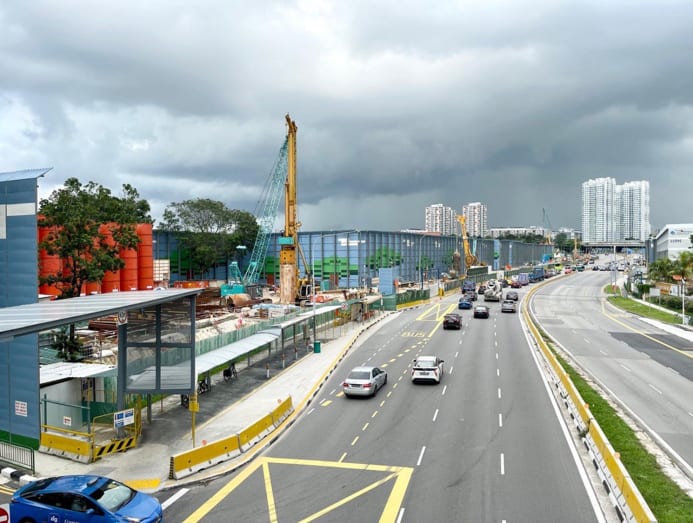The lead architect of Cross Island Line’s Tavistock MRT on what it takes to build an underground station
Ever wondered why MRT stations take almost a decade to build, although nothing seems to be happening above ground? Vivien Leong, the lead architect of Tavistock station on the future Cross Island Line gives CNA Women a glimpse of the extensive work that takes place beneath the surface.

Vivien Leong is the lead architect of Tavistock MRT station on the Cross Island Line, which will be Singapore’s longest fully underground line when completed. (Photo: Shoot You Pte Ltd)

This audio is generated by an AI tool.
My flat sits right across a future MRT station along the future Cross Island Line. From my bus stop, cranes and excavators are always visible. These construction vehicles, however, appear to be mostly stationary. Whenever we pass the site, my kids ask me why nothing seems to be moving and why they can’t build any faster.
So when I got the chance to meet Vivien Leong, the lead architect of Tavistock station, which is along Ang Mo Kio Avenue 3 and also on the Cross Island Line, that was one of the first questions I asked her.
She said: “Much of [the MRT station] is hidden from the public eye. What we see above the ground are just the exits, which comprise less than 10 per cent of the station.”

But that is just half the story.
Even underground, commuters only see one-third of the total area of the station – the concourse and platforms.
The greater part of the station is restricted to the public. We don’t know it exists, said Leong, who is studio director of the Singapore branch of London-headquartered architecture firm Scott Brownrigg.
This is one reason underground stations typically take seven to nine years to complete. “It is a very large piece of infrastructure,” Leong said.
WHAT IT TAKES TO BUILD AN MRT STATION
A station like Tavistock is around 300m long. Why does it have to be so big? The space is required to store massive equipment that most people do not even realise keeps the station running.
This includes ventilation equipment to ensure fresh air circulates underground so that the station does not get stuffy, and ensure smoke extraction as part of the fire strategy plan.
“There are hundreds of square metres of rooms and shafts required for ventilation in each station – the size of more than 10 five-room HDB flats,” Leong said.
The station also houses a complex layout of electrical and mechanical rooms, water tanks, as well as drainage solutions and equipment to pump water out of the station to prevent flooding in rainy weather.
To clear such a large underground space, a huge circular rotating machine known as the tunnel boring machine burrows through hundreds of metres of earth. Walls then have to be built to prop the soil up and prevent it from collapsing inwards before construction work can begin.

Even before this takes place, roads and public walkways need to be diverted. Hundreds of trees will also be uprooted in the process, and the same number of trees will need to be replanted after station completion, Leong explained.
Since the digging and construction takes place amid schools, and residential, retail and offices spaces, noise barriers have to be built prior.
It is a time-consuming and multi-disciplinary process involving not just Leong and her architectural team, but more than 100 experts of different fields – structural engineers, fire engineers, acoustic engineers, landscape architects and traffic engineers.
MORE THAN JUST A TRANSIT POINT
Size and scale are not the only remarkable factors of MRT construction.
“I find infrastructure projects very meaningful as they are part of our social fabric, with millions of people passing through them as part of their daily lives,” said Leong.
“A hotel or shopping mall is the end point, the destination. But transport architecture like an MRT station has a transient type of usage. You don’t visit the station like you would visit a shopping mall. You pass through it.
“Think of it as a moving machine. It is about maintaining continuous flow, and connecting and bringing people to destinations.
“We run a lot of simulations to make sure that the flow of people, the flow of trains and the flow of everything is as smooth as we can possibly make it,” Leong said.

Though a place of transit, a good station should also reflect a sense of place.
Tavistock station, for instance, is bookended by two parks – Tavistock Avenue Park and Teck Ghee Neighbourhood 4 Park – so its design concept is “Park Connected”.
Leong and her team plan to bring park-like features into the underground space to create the feeling of walking under timber pavilions with creepers growing on them, and create a seamless transition from the outside to the inside.
Like other MRT stations, it will also feature original artwork by local artists that celebrate Singapore’s history and the local community as part of Land Transport Authority’s Art in Transit programme.
“As architects, we work with curators and artists to help incorporate their art works in various spaces,” Leong said.
Well-designed stations are the ones which you move through like a breeze. You don’t notice it because everything works.
This is not Leong’s first underground station. The Singaporean, who is in her forties, had previously been involved in station modernisation works on the Piccadilly and Northern lines of the London Underground.
“There is something special about building train stations,” said Leong, adding that urban rail stations are vital to a modern city from a connectivity and sustainability viewpoint, by reducing car usage and related air pollutants.

“If you want to develop a place, you have to make sure the infrastructure is there first. The new stations might make certain areas livelier and give rise to future developments like HDB flats, condominiums, shopping malls and office blocks,” she said.
“For me personally, it is also about the creation of place and memories.
“We exist in the physical environment, but a lot of the time, we don’t really notice it. We have such busy lives, we don’t really notice things around us.
“[As architects], we want to create things that are aesthetic, functional and meaningful; and in some cases, add lively interjections into a physical environment so that it has a character of its own… and is special,” she added.
CNA Women is a section on CNA Lifestyle that seeks to inform, empower and inspire the modern woman. If you have women-related news, issues and ideas to share with us, email CNAWomen [at] mediacorp.com.sg (CNAWomen[at]mediacorp[dot]com[dot]sg).






